Apr-04-06
 | | tpstar: Interesting Ruy Lopez Cozio with an early ... g6. Black got a very playable position, then equalized with 12 ... d5 13. ed Nxd5. White played 14. Be5 to avoid 14 ... Qb6 hitting the Pd4 & the Pb2; I was going to suggest 14. Nc3?! to solve both problems but Black has 14 ... Nb6 winning the Pd4. After 16 ... Qb6 White might have tried 17. Nb3 a5 18. Nc5 similar to the game except Black doesn't get in ... f5 with tempo. 20. Bd6!? was one way to prevent 20 ... f4 trapping the Bishop, but Black swiped 2 Pawns and then got a swift Kingside attack when White declined to trade Queens (being 2 Pawns down). The end sequence is very efficient; 24. g3 is out due to 24 ... Rxe1+ 25. Qxe1 Qf3 26. Kf1 Qh1+ 27. Ke2 Re8+ wins the Queen, then 25. Kf1 fails to 25 ... Rxe1+ 26. Kxe1 (26. Qxe1? Bc4+) Re8+ 27. Kd2 Qxg2+ with a rout. |
|
| Oct-07-07 | | sanyas: 11.Ba4 intending Bc2 was surely better. |
|
Sep-26-09
 | | GrahamClayton: <Sanyas>11.Ba4 intending Bc2 was surely better. Sanyas,
After 11.♗a4 Black has 11..g5 12.♗g3 ♕b6 with a double attack on the b2 and d4 pawns. White's troubles started with 6.♗g5 ♗g7. As 7.♘c6 bc6 8. ♗ moves ♗b2 loses the exchange, 7.c3 is forced, but this means the White knight has no access to c3. |
|
Dec-08-12
 | | Fusilli: After 23...Qg4! all Black pieces but the a8-rook are engaged in the attack on the white king. Meanwhile, three white pieces are enjoying touristic views up there on the queenside. |
|
Sep-04-19
 | | KEG: An exciting attacking game by Alekhine. The game was extensively analyzed by Alekhine and years later by Taimanov (two excellent analysts). I was therefore surprised that everyone to date seems to fault the wrong move. Grigoryev's losing move was not 18. Ne4 as previously suggested but rather 19. Nc5. 1. e4 e5
2. Nf3 Nc6
3. Bb5 Nge7
As tpstar on this site has spotted, this is the Cozio Defense to the Ruy Lopez. "Alekhine's opening repertoire was unusually wide, and he often adopted unusual variations, sometimes those condemned by theory, always bringing in original ideas." (Taimanov). 4. d4
A favorite of Blackburne, who played it at least four times. Pillsbury also tried this line against the Cozio. The text along with 4. 0-0 and 4. c3 are most frequently played. Taimanov preferred 4. 0-0, and criticized the text: "This straightforward move (i.e., 4. d4) does not pose any problems. Nowadays: 4. 0-0 g6 5, c3 Bg7 6. d4 is considered more promising." Alekhine himself, however had other ideas for White here: "I consider 4. Nc3 g6 5. d4 Bg7 [5...exd4 looks better for Black and seems to lead to near equality for Black--KEG] 6. Bg5 [6. dxe5 is better--KEG] h6 [6...exd4 seems best---KEG]. 7. Be3." So far as I can see, all of the options discussed are reasonable, and the choice is primarily one of style. After Grigoryev' actual 4. d4, the position was: 
click for larger view4... exd4
5. Nxd4
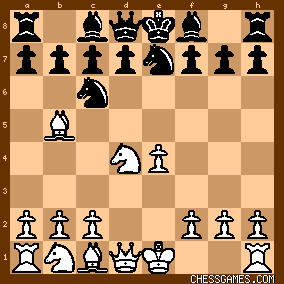
click for larger view5... g6
Another option, 5...NxN was discussed by Taimanov: "According to theory:
5... NxN
6. QxN Nc6
7. Qd3
7. Qd5 and 7. Qe3 also yield a small plus for White.
7... Bc5
is good enough for equality [7...a6 and 7...Bd6 were also good--KEG]
To meet:
8. BxN [8. Be3 looks better]
by 8...dxc6?!
9. QxQ+ KxQ
Obviously such simplification did not appeal to Alekhine, who preferred a more complicated line." [In Taimanov'a line, 9. Qg3 would be a good option--KEG] 6. Bg5
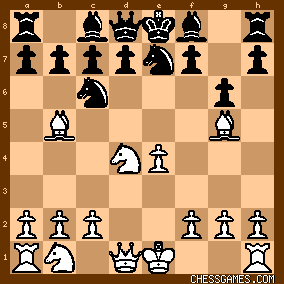
click for larger viewAn innovation not tried before or since so far as I can find. MCO-13 gives 6. Nc3 or 6. NxN, which seem best. Taimanov did not like 6. Bg5:
"Not a good line. The harmonius way was 6. Nc3." Graham Clayton on this site agreed with Taimonov: "White's troubles started with 6. Bg5."
These critiques seem well-founded, but as the sequel demonstrates White got very much back into the game soon enough and only lost because of a later error. 6... Bg7
Alekhine was clearly better at this point.
7. c3

click for larger view"The entire set-up is not to be recommended, since the Queen's Knight is deprived of its best development square." (Alekhine). :Here comes the concession for his pseudo-action Bishop move--the Knight loses access to the natural square at c3." (Taimanov). |
|
Sep-05-19
 | | KEG: Post II
7... h6
Alekhine could have exploited Grigoryev's doubtful 6. Bg5 by now playing 7...NxN (followed by 8...c6 and then 9...h6) and thus giving himself targets in the White camp he could later try to exploit. But--as noted by Taimanov earlier--Alekhine preferred complications to exchanges, even when this could give him a theoretically better game. Since Alekhine ultimately did trade Knights (9...NxN), he might as well have done so here. 8. Bh4
This later gives Alekhine to gain time and space with g5. 8. Be3 was much better. 8... 0-0
Once again, Alekhine could have gotten much the better game by trading Knights (i.e., 8...NxN 9. cxN c6 followed by 10...d5). 9. 0-0
9. NxN would have forestalled Alehkine's coming 9...NxN and 10. c6. 9. Nb3 was another way to prevent Alekhine's next maneuver and was also better than the text. 9... NxN
"?!"--(Taimanov).
Better late than never!
"Alekhine always thought in concrete fashion. This exchange creates a target in the center and enables Black [to] seize the initiative." (Taimanov). Alekhine could also also have played 9...g5 here and after 10. Bg3 trade Knights. 10. cxN

click for larger view10... c6
10...g5 and 10. d5 were also strong here.
11. Bc4
"After other Bishop moves Black could have won a pawn by 11...g5. 12 Bg3 Qb6 which would now fail after 13. Bd6 Re8 14. Qf3." (Alekhine). "Here the Bishop is on a poor square where it enhances the strength of Black's planned central break. However, there was no better move oa other retreats are met by the awkward replay 11...g5 12. Bg3 Qb6." (Taimanov). I agree that Alekhine had the better game at this point, but the notion that other Bishop moves were significantly inferior and would be met effectively by 11...g5 and then 12...Qb6 is doubtful: A) If 11. Bd3 (probably White's best), Alekhine should then have played 11...Bxd4 after which White would have some--but probably not sufficient--compensation for the pawn. If instead 11...g5 12. Bg3 Qb6? as suggested (12...Bxd4 or 12...d5 were better with soe edge to Black in either case) White could play the very strong 13. Bd6! after which Black would probably do best to sacrifice the exchange (e.g., 13...Ng6 14. e5 Qxb2 15. BxR NxB 16. Qd2 QxQ (not 16...QxR? 17. Nc3) 17. NxQ with some advantage to White who is up the exchange for a pawn. B) 11. Be2 was also playable. If then 11...g5 12. Bg3 Qb6 (12...d5 would be stronger and would give Black a good game) 13. Nc3 Qxd4 14. Qc2 and White would have some compensation (much better development) for the lost pawn. C) 11. Ba4 was also a reasonable choice. I then 11...g5 12. Bg3 Qb6? (Black can get the better game with 12...d5!) 13. Bd6! with much better chances for White. In sum, 11. Bc4 was one of several reasonable choices for White. The other options also leave White with the inferior game,but the idea of 12...Qb6 was not the road in those lines to an significant edge for Black, and in some cases could lead to trouble. 11... g5
12. Bg3

click for larger view12... d5!
"Here, however, the tempting 12...Qb6 would fail to 13. Bd6 Re8. Qf3. [In this line, 13...Qxd4, though leaving Black poorly situated, was the only chance and would lead to fascinating play: e.g., 14. QxQ BxQ 15. BxN Re8 16. Bd6 Bxb2 17. Nd2 b5 18. Bb3 BxR 19. RxB and White--though nominally behind in material (i.e., Bishop and Knight for two pawns) obviously would have the initiative and Black badly bottled up by the White Bishop at d6]. tpstar on this site states that Alekhine "equalized" with 12...d5, but Black in fact is definitely better and lost his edge only because of second-best moves in his next few turns (that I will discuss in my next post on this game. After 12...d5 the position was:

click for larger view |
|
Sep-05-19
 | | KEG: Post III
13. exd5 Nxd5
"Now Black stands very well, and he has the prospect of successfully attacking the weakness on d4." (Alekhine) In his zeal to be able to attack White's d4 pawn with his Queen, Alekhine overlooked that 13...cxd5--which would allow 14...Nc6--was better. The position after 13...Nxd5 was:
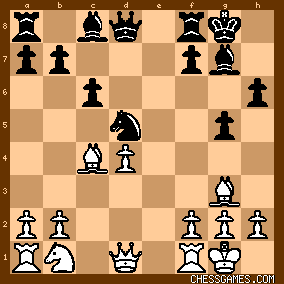
click for larger view15. Be5
As Alekhine and Taimanov both noted, 15. Nc3 would allow Black to gain the advantage with 15...Nb6 ; e.g., 16. Bb3(my line--neither Alekhine nor Taimanov supplied one) 15...Qxd4 (better than 15...Bxd4 16. Qc2) 16. QxQ BxQ 17. Rad1 Bg7 (17...BxN 18. bxB would give Black the two Bishops and thus at least partial compensation for the lost pawn) 18. f4 gxf4 19. Rxf4 Be6 20. BxB fxB 21. Rg4 leaving Black a pawn up but White with some compensation. tpstar's suggested 14...Qb6 (after 14. Nc6) would not be good since White would be better after 15. BxN cxB 16. Nxd5 Qxb2 17. Rc1 [even better than 17. Be5] After 14. Be5, the position was:
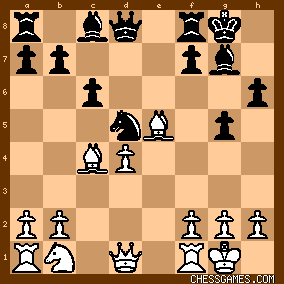
click for larger view14... Be6
15. Nd2
"Apparently White did not yet sense the danger or else he would have preferred the exchange: 15. BxB KxB 16. BxN BxB 17. Nc3 with good chances of neutralizing the enemy pressure." (Taimanov). White is still worse on Taimanov's line. More importantly, the "danger" Taimanov cites is based--as will be seen--on a mis-evaluation of the position. White is not in any severe danger here because of the counter-play available to him that appears to have been missed by the commentators. 15... f6
"Here 15...Qb6 threatening 16...f6 would perhaps have been better." (Alekhine). I agree with Alekhine's assessment of the relative merits of 15...f5 and 15...Qb6. But there may have been even stronger moves, e.g., 15...Re8; 15...Bf5; or 15...Qe7. In any event, Black will have at most a tiny advantage. 16. Bg3
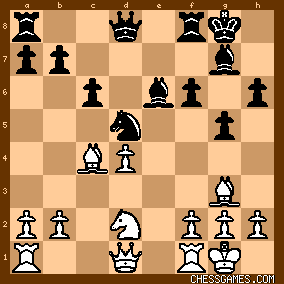
click for larger view16... Qb6
"!"--(Taimanov)
"A fresh reminder about the tender spots at b2 and d4." (Alekhine). In fact, White is well situated to meet the threats mentioned by Alekhine and Taimanov. Someone better therefore was 16...Bf7 or 16...Re8. 17. Re1
"White might have tried 17. Nb3 a5 [17...Bf7 or 17...Rfe8 would be better and would yield approximately equal chances] 18. Nc5 similar to the game except that Black doesn't get in f5 with tempo." (tpstar on this site). In fact, White appears to have much the better chances on tpstar's line, but only because 17...a5. With best play on both sides, either the text (17. Re1) or tpstar's suggested 17. Nb3 the game is in the balance. 17... Rfe8
The text seems to be based on the (mistaken) notion that 18. Ne4 would be bad for White. After the text, as I will attempt to show, White is better on all lines. Best for Black here was 17...Bf7 (or perhaps 17...Bf5). The position after 17...Rfe8 was:

click for larger viewThe climax of the game had been reached. The key question is whether White can afford to play 18. Ne4 [as I believe is the case] or whether that that move [that was played by Grigoryev here] was a blunder. I will attempt to defend my minority view on this topic in my next post on this game. |
|
Sep-07-19
 | | KEG: Post IV
18. Ne4!
I love this move. So does Fritz and Stockfish. But the earlier commentators disagree strenously: "?"--(Taimanov)
"The decisive mistake, instead of which 18. Nb3 should have been played, with a tenable game." (Alekhine) "Once again, too optimistic. The threats 19. Nd6 and 19. Nc5 look strong [perhaps because they ARE strong--KEG], but, strange as it may seem, the move is a definite mistake, which Black duly demonstrates. White had to try the defensive 18. Nb3." (Taimanov). 18. Nb3, which Alekhine and Taimanov thought best, would allow Black to seize the advantage with 18...Qb4 [e.g., 19. Nc5 Bf7 20. b3 b5 21. BxN BxB 22. f3 f5. Thus, the question presented is how good or bad Grigoryev's 18. Ne4 was. To answer this, we must look at what followed.
After 18. Ne4, the position was:

click for larger view18... f5?
"!"--(Alekhine, Taimanov).
Another differing assessment. 18...Bf7 or 18...Bf5 were probably the only way to avoid trouble. But let's hear from Taimanov for a diametrically differing view of 18....f5: "This tricky counter-stroke had probably been foreseen by Alekhine some moves ago. Play now enters forcing lines with his pieces developing destructive energy." The position after 18...f5 was:

click for larger view19. Nc5?
Now the differing views of the position come to a head. Grigorvev should have played 19. Nd6! But Alekhine and Taimanov disagreed strongly: "19. Nd6 would be simply met by 19...f4." (Alekhine). "White has to lose material in a y event. 19. Nd6 f4 20. NxR RxN." (Taimanov). I certainly agree that 19. Nd6 f4 20. NxR RxN would be bad for White. But after 19. Nd6 f4, White gets excellent (and perhaps even winning) chances with 20. Qh5!, a move apparently not considered by either Alekhine or Taimanov [and obviously missed by Grigoryev]. Black's best retort is 20...Qxd4 (if 20...fxB 21.hxg3 Re7 22. RxB! RxR 23. Qf7+ Kh8 24. QxR Qxd4 25. Nf7+ Kh7 26. Bb3 Qxb2 27. Re1 Qf6 28. Bc2+ Kg8 29. Nxh6+ Kh8 30. Nf7+ Kg8 31. Nxg5+ QxQ 32. NxQ and White is a pawn up in with good winning chances despite his doubled pawn and the Bishops of opposite colors) 21. Rad1 Qxb2 22. RxB! RxR 23. Qf7+ Kh8 24. QxR Qf6 25. Nf7+ Kh7 26. Bd3+ Kg8 27. Nxh6+ Kh8 28. Nf7+ Kg8 29. Nxg5+ QxQ 30. NxQ fxB 31. hxg3 with good winning chances in the ending because of th passed King-side pawns. From what I could see, Alekhine would at best have been struggling for a draw after 19. Nd6 with best play. But after the text move (19. Nc5?), the position was: 
click for larger viewBlack has a clear win here, and Alekhine--with the exception of an arguable glitch on move 20--closed out the game with his usual energy. 19... Bf7!
"Now White has to save his threatened Bishop, and first he loses a pawn." (Alekhine). 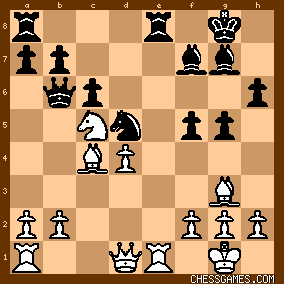
click for larger view20. Bd6
"There is no better move against the threatened f4." (Taimanov). "20. Bd6?! was one way to prevent 20...f4 trapping the Bishop, but Black swipped 2 pawns and then got a swift King-side attack when White declined to trade Queens." (tpstar on this site). The main alternative was 20. BxN, but then Alekhine would win easily with 20...BxB 21. Bd6 RxR+ 22. QxR Bxd4. The position after 20. Bd6 was:

click for larger view |
|
Sep-07-19
 | | KEG: Post V
20... Qxb2
This was almost certainly sufficient to win. But 20...RxR+ seems a clear and simpler road to victory, e.g., 21. QxR Re8 22. Qd2 Rd8 23. BxN cxB 24. Bb8! [a nice try although insufficient] RxB 25. Nd7 Qd6 26. NxR QxN and Black's two Bishops are far more powerful than White's Rook and should lead to a win. After 20...Qxb2, the position was:
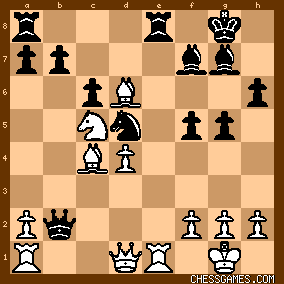
click for larger view21. BxN?
After this White was clearly sunk, as Alekhine proceeded to demonstrate with ruthless efficiency and tactical brilliance. Grigoryev had to try 21. Be5 or 21. Re5. I'm not saying that either of these moves would necessarily have saved the game. But it would have avoided the immediate massacre that followed after the text. 21... BxB
21...RxR or 21...cxB would also win for Black.
22. Rb1?
"This counter-action proves to be immediately ruinous, since Black suddenly obtains a mating attack. But in any case White's game was lost." (Alekhine) "White's last chance to go for active piece play, but Alekhine has foreseen this." (Taimanov). 22. Be5 would have avoided the immediate catastrophe that now befell White's game, but--as Alekhine notes--neither that nor any other move had any serious prospect of changing the outcome. The position after 22. Rb1 was:
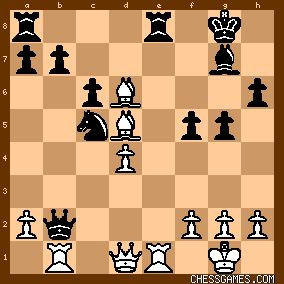
click for larger view22... Qxd4
"It is instructive to see that Black has worked upon both weak pawns." (Taimanov). 22...RxR+ first (and then 23...Qxd4) would also have won, but the text was even better. 23. Rxb7?
This allowed Alekhine to wrap up the game immediately with one of the thrilling and unexpected tactical strokes for which he became famous. But other moves held out nothing other than the chance to survive a few moves longer. The position after 23...Rxb7 was:

click for larger viewBlack to move and win.
23... Qg4!
"!"--(Alekhine)
"!!"--(Taimanov)
"A surprising finish." (Alekhine).
"A tactical stroke typical of Alekhine, transferring play from one side of the board to another with inexorable mating threat." (Taimanov). 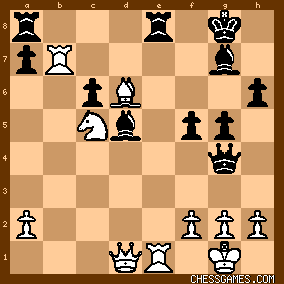
click for larger view |
|
Sep-07-19
 | | KEG: Post VI
24. f3
This allows a quick spectacular finish, but everything else was also hopeless. 24. Bg3 was arguably "best," but as Alekhine demonstrated in his commentary on the game, it offered no hope of salvation (since Black then wins a piece): "On 24. Bg3 24...QxQ 25. RxQ f4." (Alekhine)
Taimanov, in turn, disposed of 24. g3:
"Or 24. g3 Qh3 (24...RxR+ 25. QxR Qf3 26. Kf1 Qh1+ 27. Ke2 Re8+ is even more brutal, as previously pointed out on this site by tpstar) 25. RxR+ [White could perhaps extend the game by a 25. Ne4 sacrifice, but Black would then be up a Rook and still have a vicious attack after 25...BxN 26. RxB RxR] RxR 26. Qf1 [this allows mate in 4, but the "better" 26. Ne4 or 26. RxB+ would only extend the game by a few moves] Re1! (Taimanov). After Grigoryev's actual move (24. f3), the position was: 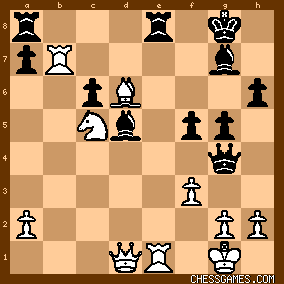
click for larger view24... Bd4+
25. Kh1
As Taimanov pointed out, 25. Kf1 would also not have saved the day: " 25. Kf1 Bc4+ 26. Nd3 (26. Re2 might extend the game slightly but would have been no fun at all for White after 26...BxR+ 27. QxB RxQ 28. fxQ Rae8 where Black is up the exchange with a lethal attack) 26...RxR+ 27. KxR Bc3+ 28. Kf1 Qd4 [after which Black gobbles up the White army]." After 25. Kh1 (Grigorvey's move), the position was: 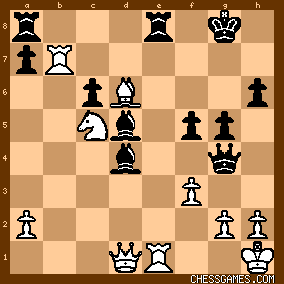
click for larger view25... Bxf3!
"!"--(Alekhine)(Taimanov)
0-1
"After 26. RxR+ RxR 27. gxB mate follows in two moves." (Alekhine) [i.e., 27...Re1! 28. QxR Qxf3 mate A beautiful finish by Alekhine. |
|
Nov-02-20
 | | kingscrusher: Yep as mentioned Nd6 is curiously winning for White it seems. Black seems to have some f7 issues which can be exploited tactically in the f4 variations. |
|
Nov-02-20
 | | KEG: I see that my diagrams after 22. Rb1 and after 23. Rxb7 are flawed. The Knight on c5 should be a WHITE Knight and the Bishop on d5 should be a BLACK Bishop. My apologies to anyone who was mislead. |
|
|
|
|





